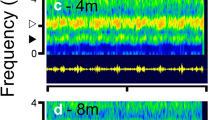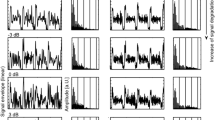Abstract
Despite the importance of perceptually separating signals from background noise, we still know little about how nonhuman animals solve this problem. Dip listening, an ability to catch meaningful ‘acoustic glimpses’ of a target signal when fluctuating background noise levels momentarily drop, constitutes one possible solution. Amplitude-modulated noises, however, can sometimes impair signal recognition through a process known as modulation masking. We asked whether fluctuating noise simulating a breeding chorus affects the ability of female green treefrogs (Hyla cinerea) to recognize male advertisement calls. Our analysis of recordings of the sounds of green treefrog choruses reveal that their levels fluctuate primarily at rates below 10 Hz. In laboratory phonotaxis tests, we found no evidence for dip listening or modulation masking. Mean signal recognition thresholds in the presence of fluctuating chorus-like noises were never statistically different from those in the presence of a non-fluctuating control. An analysis of statistical effects sizes indicates that masker fluctuation rates, and the presence versus absence of fluctuations, had negligible effects on subject behavior. Together, our results suggest that females listening in natural settings should receive no benefits, nor experience any additional constraints, as a result of level fluctuations in the soundscape of green treefrog choruses.




Similar content being viewed by others
References
Alder TB, Rose GJ (1998) Long-term temporal integration in the anuran auditory system. Nat Neurosci 1:519–523
Arch VS, Narins PM (2008) ‘Silent’ signals: selective forces acting on ultrasonic communication systems in terrestrial vertebrates. Anim Behav 76:1423–1428
Bacon SP, Grantham DW (1989) Modulation masking: effects of modulation frequency, depth, and phase. J Acoust Soc Am 85:2575–2580
Bacon SP, Opie JM, Montoya DY (1998) The effects of hearing loss and noise masking on the masking release for speech in temporally complex backgrounds. J Speech Lang Hear R 41:549–563
Bee MA (2007) Selective phonotaxis by male woodfrogs (Rana sylvatica) to the sound of a chorus. Behav Ecol Sociobiol 61:955–966
Bee MA, Micheyl C (2008) The cocktail party problem: what is it? How can it be solved? And why should animal behaviorists study it? J Comp Psychol 122:235–251
Bee MA, Riemersma KK (2008) Does common spatial origin promote the auditory grouping of temporally separated signal elements in grey treefrogs? Anim Behav 76:831–843
Bee MA, Schwartz JJ (2009) Behavioral measures of signal recognition thresholds in frogs in the presence and absence of chorus-shaped noise. J Acoust Soc Am 126:2788–2801
Bee MA, Buschermöhle M, Klump GM (2007) Detecting modulated signals in modulated noise: (II) neural thresholds in the songbird forebrain. Eur J Neurosci 26:1979–1994
Bee MA, Vélez A, Forester JD (2012) Sound level discrimination by Cope’s gray treefrog (Hyla chrysoscelis) in the presence and absence of chorus-shaped noise. J Acoust Soc Am 135:4188–4195
Branstetter BK, Finneran JJ (2008) Comodulation masking release in bottlenose dolphins (Tursiops truncatus). J Acoust Soc Am 124:625–633
Brumm H, Slabbekoorn H (2005) Acoustic communication in noise. Adv Stud Behav 35:151–209
Bush SL, Gerhardt HC, Schul J (2002) Pattern recognition and call preferences in treefrogs (Anura: Hylidae): a quantitative analysis using a no-choice paradigm. Anim Behav 63:7–14
Christie K, Schul J, Feng AS (2010) Phonotaxis to male’s calls embedded within a chorus by female gray treefrogs, Hyla versicolor. J Comp Physiol A 196:569–579
Cohen J (1988) Statistical power analysis for the behavioral sciences, 2nd edn. Erlbaum, Hillsdale
Cooke M (2006) A glimpsing model of speech perception in noise. J Acoust Soc Am 119:1562–1573
Diekamp B, Gerhardt HC (1995) Selective phonotaxis to advertisement calls in the gray treefrog Hyla versicolor: behavioral experiments and neurophysiological correlates. J Comp Physiol A 177:173–190
Fay RR (2011) Signal-to-noise ratio for source determination and for a comodulated masker in goldfish, Carassius auratus. J Acoust Soc Am 129:3367–3372
Füllgrabe C, Berthommier F, Lorenzi C (2006) Masking release for consonant features in temporally fluctuating background noise. Hear Res 211:74–84
Gerhardt HC (1975) Sound pressure levels and radiation patterns of vocalizations of some North American frogs and toads. J Comp Physiol A 102:1–12
Gerhardt HC (1981) Mating call recognition in the green treefrog (Hyla cinerea): importance of two frequency bands as a function of sound pressure level. J Comp Physiol A 144:9–16
Gerhardt HC (1995) Phonotaxis in female frogs and toads: execution and design of experiments. In: Klump GM, Dooling RJ, Fay RR, Stebbins WC (eds) Methods in comparative psychoacoustics. Birkhäuser, Basel, pp 209–220
Gerhardt HC (2001) Acoustic communication in two groups of closely related treefrogs. Adv Stud Behav 30:99–167
Gerhardt HC, Huber F (2002) Acoustic communication in insects and anurans: common problems and diverse solutions. Chicago University Press, Chicago
Gerhardt HC, Klump GM (1988a) Masking of acoustic signals by the chorus background noise in the green treefrog: a limitation on mate choice. Anim Behav 36:1247–1249
Gerhardt HC, Klump GM (1988b) Phonotactic responses and selectivity of barking treefrogs (Hyla gratiosa) to chorus sounds. J Comp Physiol A 163:795–802
Gerhardt HC, Tanner SD, Corrigan CM, Walton HC (2000) Female preference functions based on call duration in the gray tree frog (Hyla versicolor). Behav Ecol 11:663–669
Gooler DM, Feng AS (1992) Temporal coding in the frog auditory midbrain: the influence of duration and rise-fall time on the processing of complex amplitude-modulated stimuli. J Neurophysiol 67:1–22
Grafe TU, Dobler S, Linsenmair KE (2002) Frogs flee from the sound of fire. P R Soc B 269:999–1003
Gustafsson HA, Arlinger SD (1994) Masking of speech by amplitude-modulated noise. J Acoust Soc Am 95:518–529
Höbel G (2011) Variation in signal timing behavior: implications for male attractiveness and sexual selection. Behav Ecol Sociobiol 65:1283–1294
Höbel G, Gerhardt HC (2007) Sources of selection on signal timing in a treefrog. Ethology 113:973–982
Hofer SB, Klump GM (2003) Within- and across-channel processsing in auditory masking: a physiological study in the songbird forebrain. J Neuosci 23:5732–5739
Hulse SH (2002) Auditory scene analysis in animal communication. Adv Stud Behav 31:163–200
Jensen KK (2007) Comodulation detection differences in the hooded crow (Corvus corone cornix), with direct comparison to human subjects. J Acoust Soc Am 121:1783–1789
Jones DL, Jones RL, Ratnam R (2009) Dynamical interactions in a green treefrog chorus. J Acoust Soc Am 126:2270
Joris PX, Schreiner CE, Rees A (2004) Neural processing of amplitude-modulated sounds. Physiol Rev 84:541–577
Klump GM (1996) Bird communication in the noisy world. In: Kroodsma DE, Miller EH (eds) Ecology and evolution of acoustic communication in birds. Cornell University Press, Ithaca, pp 321–338
Klump GM, Langemann U (1995) Comodulation masking release in a songbird. Hear Res 87:157–164
Klump GM, Benedix JH Jr, Gerhardt HC, Narins PM (2004) AM representation in green treefrog auditory nerve fibers: neuroethological implications for pattern recognition and sound localization. J Comp Physiol A 190:1011–1021
Kwon BJ, Turner CW (2001) Consonant identification under maskers with sinusoidal modulation: masking release or modulation interference? J Acoust Soc Am 110:1130–1140
Langemann U, Klump GM (2001) Signal detection in amplitude-modulated maskers. I. Behavioural auditory thresholds in a songbird. Eur J Neurosci 13:1025–1032
Langemann U, Klump GM (2005) Perception and acoustic communication networks. In: McGregor PK (ed) Animal communication networks. Cambridge University Press, Cambridge, pp 451–480
Langemann U, Klump GM (2007) Detecting modulated signals in modulated noise: (i) behavioural auditory thresholds in a songbird. Eur J Neurosci 26:1969–1978
Marshall VT, Schwartz JJ, Gerhardt HC (2006) Effects of heterospecific call overlap on the phonotactic behaviour of grey treefrogs. Anim Behav 72:449–459
Nelken I, Rotman Y, Bar Yosef O (1999) Responses of auditory-cortex neurons to structural features of natural sounds. Nature 397:154–157
Nieder A, Klump GM (2001) Signal detection in amplitude-modualted maskers. II. Processing in the songbird’s auditory forebrain. Eur J Neurosci 13:1033–1044
Nityananda V, Bee MA (2012) Spatial release from masking in a free-field source identification task by gray treefrogs. Hear Res 285:86–97
Noldus (2005) EthoVision® Video Tracking System for Automation of Behavioral Experiments: Reference Manual Version 3.1. Noldus Information Technology, Wageningen, The Netherlands
Oldham RS, Gerhardt HC (1975) Behavioral isolation of the treefrogs Hyla cinerea and Hyla gratiosa. Copeia 1975:223–231
Patterson RD, Moore BCJ (1986) Auditory filters and excitation patterns as representations of frequency resolution. In: Moore BCJ (ed) Frequency selectivity in hearing. Academic, London, pp 123–177
Richards DG, Wiley RH (1980) Reverberations and amplitude fluctuations in the propagation of sound in a forest: implications for animal communication. Am Nat 115:381–399
Ronacher B, Hoffmann C (2003) Influence of amplitude modulated noise on the recognition of communication signals in the grasshopper Chorthippus biguttulus. J Comp Physiol A 189:419–425
Rose GJ, Capranica RR (1984) Processing amplitude-modulated sounds in the auditory midbrain of two species of toads: matched temporal filters. J Comp Physiol A 154:211–219
Rose GJ, Gooler DM (2006) Function of the amphibian central auditory system. In: Narins PM et al (eds) Hearing and sound communication in amphibians. Springer, New York, pp 250–290
Rose GJ, Brenowitz EA, Capranica RR (1985) Species specificity and temperature dependency of temporal processing by the auditory midbrain of two species of treefrogs. J Comp Physiol A 157:763–769
Rosenthal R, Rosnow RL (1991) Essentials of behavioral research: methods and data analysis, 2nd edn. McGraw-Hill, New York
Schul J, Bush SL (2002) Non-parallel coevolution of sender and receiver in the acoustic communication system of treefrogs. P R Soc B 269:1847–1852
Schwartz JJ, Freeberg TM (2008) Acoustic interaction in animal groups: signaling in noisy and social contexts—introduction. J Comp Psychol 122:231–234
Schwartz JJ, Gerhardt HC (1989) Spatially mediated release from auditory masking in an anuran amphibian. J Comp Physiol A 166:37–41
Schwartz JJ, Marshall VT (2006) Forms of call overlap and their impact on advertisement call attractiveness to females of the gray treefrog, Hyla versicolor. Bioacoustics 16:39–56
Shannon RV, Zeng FG, Kamath V, Wygonski J, Ekelyd M (1995) Speech recognition with primarily temporal cues. Science 5234:303–304
Swanson EM, Tekmen SM, Bee MA (2007) Do female anurans exploit inadvertent social information to locate breeding aggregations? Can J Zoolog 85:921–932
Vélez A, Bee MA (2010) Signal recognition by frogs in the presence of temporally fluctuating chorus-shaped noise. Behav Ecol Sociobiol 64:1695–1709
Vélez A, Bee MA (2011) Dip listening and the cocktail party problem in grey treefrogs: signal recognition in temporally fluctuating noise. Anim Behav 82:1319–1327
Vélez A, Bee MA (2012) Signal recognition by green treefrogs (Hyla cinerea) and Cope’s gray treefrogs (Hyla chrysoscelis) in naturally fluctuating noise. J Comp Psychol (in press)
Vélez A, Schwartz JJ, Bee MA (in press). Anuran signal perception in noisy environments. In: Brumm H (ed) Animal communication and noise. Springer, New York
Vestergaard MD, Fyson NRC, Patterson RD (2011) The mutual roles of temporal glimpsing and vocal characteristics in cocktail-party listening. J Acoust Soc Am 130:429–439
von Helversen D, von Helversen O (1997) Recognition of sex in the acoustic communication of the grasshopper Chorthippus biguttulus (Orthoptera, Acrididae). J Comp Physiol A 180:373–386
Wiley RH, Richards DG (1978) Physical constraints on acoustic communication in the atmosphere: implications for the evolution of animal vocalizations. Behav Ecol Sociobiol 3:69–94
Acknowledgments
All procedures for collecting, handling, and testing animals were approved by the University of Minnesota’s Institutional Animal Care and Use Committee (IACUC No. 0809A46721, November 2008). We thank N. Buerkle, M. Caldwell, B. Chicoine, J. Cook, C. Espegard, S. Feingold, N. Hein, K. Heino, J. Henly, S. Hinrichs, M. Johnson, J. Kleinschmidt, B. Linehan-Skillings, J. Mertz, V. Nityananda, C. Nguyen, S. Peterson, A. Rapacz Van-Neuren, and especially S. Tekmen for help testing frogs, R. Sparrow for access to frog breeding sites, and M. Caldwell, B. Pettit, K. Schrode, and J. Ward for feedback on earlier versions of the manuscript. This work was supported by a UMN Graduate School Thesis Research Grant and a Dayton-Wilkie Fellowship to A. Vélez and by NSF IOS 0842759 and NIDCD 5R01DC009582 to M. Bee.
Author information
Authors and Affiliations
Corresponding author
Electronic supplementary material
Below is the link to the electronic supplementary material.
Rights and permissions
About this article
Cite this article
Vélez, A., Höbel, G., Gordon, N.M. et al. Dip listening or modulation masking? Call recognition by green treefrogs (Hyla cinerea) in temporally fluctuating noise. J Comp Physiol A 198, 891–904 (2012). https://doi.org/10.1007/s00359-012-0760-z
Received:
Revised:
Accepted:
Published:
Issue Date:
DOI: https://doi.org/10.1007/s00359-012-0760-z




